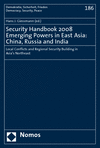Security Handbook 2008. Emerging Powers in East Asia: China, Russia and India
Local Conflicts and Regional Security Building in Asia's Northeast
Abstract
Security Handbook is a series on regional security developments and cooperation. Security Handbook 2008 turns its face to Asia. India, Russia, and particularly China have become new challengers for the regional East Asian order. Distinguished analysts from the region, the U.S. and Europe reflect on causes, results and tendencies of recent power shifts. The analyses hint at risks and chances to employ the capability of emerging powers for the sake of regional stability and cooperation. Ironically, Russia’s, India’s and also China’s rises offer fewer risks than opportunities for resolving bilateral and regional conflicts and for mastering global challenges in a regional context. The provided picture is completed by reviewing the two “hot spots” in East Asia, and by a discussion of whether there should be a shaping role for a European actor or mediator in the region. A statistical appendix provides facts and figures for additional reference.
The Editor, Prof. Dr. Dr. Hans J. Giessmann, is the Deputy Director of the Institute for Peace Research and Security Policy (IFSH) in Hamburg and Head of the Centre for European Peace and Security Studies (ZEUS). He is editor of the research book series “Demokratie, Sicherheit, Frieden” and member of the advisory board of the security-political journal “S+F. Sicherheit und Frieden – Security and Peace”.
Zusammenfassung
Security Handbook is a series on regional security developments and cooperation. Security Handbook 2008 turns its face to Asia. India, Russia, and particularly China have become new challengers for the regional East Asian order. Distinguished analysts from the region, the U.S. and Europe reflect on causes, results and tendencies of recent power shifts. The analyses hint at risks and chances to employ the capability of emerging powers for the sake of regional stability and cooperation. Ironically, Russia’s, India’s and also China’s rises offer fewer risks than opportunities for resolving bilateral and regional conflicts and for mastering global challenges in a regional context. The provided picture is completed by reviewing the two “hot spots” in East Asia, and by a discussion of whether there should be a shaping role for a European actor or mediator in the region. A statistical appendix provides facts and figures for additional reference.
The Editor, Prof. Dr. Dr. Hans J. Giessmann, is the Deputy Director of the Institute for Peace Research and Security Policy (IFSH) in Hamburg and Head of the Centre for European Peace and Security Studies (ZEUS). He is editor of the research book series “Demokratie, Sicherheit, Frieden” and member of the advisory board of the security-political journal “S+F. Sicherheit und Frieden – Security and Peace”.
- 241–255 Facts and Figures 241–255
- 256–256 Contributors 256–256

